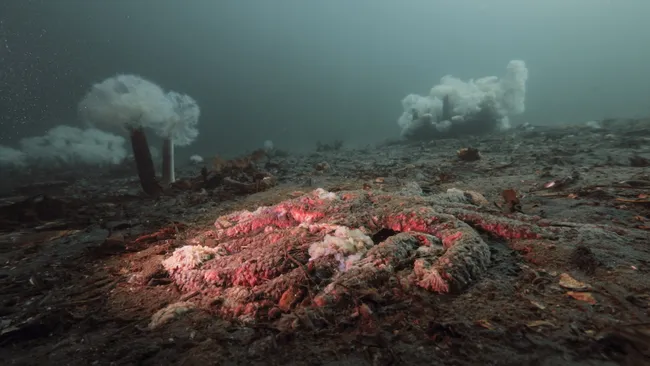Mystery of why sea stars keep turning into goo finally solved — and it's not what scientists thought
Scientists Solve Decade-Old Mystery of "Melting" Sea Stars, Citing Bacteria as Culprit
By သုခဟိန်း (ThuKhaHein) • August 7, 2025
A team of researchers has finally solved the decade-long mystery behind the catastrophic "sea star wasting syndrome" that has killed billions of sea stars along the North American Pacific coast, a finding that contradicts previous theories. Published in the journal Nature Ecology & Evolution, the study identifies a specific strain of the bacterium Vibrio pectenicida as the definitive cause, rather than the virus that was initially suspected. The breakthrough came after scientists from institutions including the Hakai Institute and the University of British Columbia shifted their focus from examining external tissues to analyzing the internal coelomic fluid of live sea stars, where the deadly microbe was found in high concentrations. The epidemic, which began in 2013, has ravaged more than 20 species and is directly responsible for a 90% decline in the sunflower sea star population, a key predator. The ecological consequences have been severe; as marine disease ecologist Alyssa Gehman noted, the loss of sea stars has led to a population explosion of sea urchins, which in turn have decimated vital kelp forests, a crucial habitat for countless other species. Now that the true culprit has been identified, scientists are hopeful that targeted conservation efforts and further research into the link between the bacteria and rising ocean temperatures can begin.
သမုဒ္ဒရာကြယ်ငါးများ "အရည်ပျော်" သည့် လျှို့ဝှက်ချက် ဆယ်စုနှစ်အကြာတွင် ဖြေရှင်းနိုင်ပြီဖြစ်ကြောင်း သိပ္ပံပညာရှင်များပြောကြား
By သုခဟိန်း (ThuKhaHein) • ဩဂုတ် ၇၊ ၂၀၂၅
မြောက်အမေရိက ပစိဖိတ်ကမ်းရိုးတန်းတစ်လျှောက်ရှိ သမုဒ္ဒရာကြယ်ငါးဘီလီယံနှင့်ချီ၍ သေဆုံးစေခဲ့သော ဆယ်စုနှစ်ကြာ “ကြယ်ငါး အရည်ပျော်ရောဂါ” (sea star wasting syndrome) နောက်ကွယ်မှ လျှို့ဝှက်ချက်ကို သုတေသီအဖွဲ့တစ်ဖွဲ့က နောက်ဆုံးတွင် ဖော်ထုတ်နိုင်ခဲ့ပြီဖြစ်ရာ၊ ၎င်းသည် ယခင်က ယူဆထားသော သီအိုရီများနှင့် ကွဲလွဲနေသည်။ Nature Ecology & Evolution ဂျာနယ်တွင် ဖော်ပြခဲ့သော အဆိုပါလေ့လာမှုက ရောဂါ၏ အဓိက တိကျသော အကြောင်းရင်းမှာ ယခင်က သံသယရှိခဲ့သော ဗိုင်းရပ်စ်မဟုတ်ဘဲ Vibrio pectenicida ဟုခေါ်သော ဘက်တီးရီးယား မျိုးစိတ်တစ်ခုဖြစ်ကြောင်း ဖော်ထုတ်ခဲ့သည်။ Hakai Institute နှင့် University of British Columbia ကဲ့သို့သော အဖွဲ့အစည်းများမှ သိပ္ပံပညာရှင်များသည် ယခင်က အဖြေမထုတ်နိုင်ခဲ့သော ပြင်ပတစ်သျှူးများကို စစ်ဆေးခြင်းမှနေ၍ သေစေနိုင်သော ပိုးမွှားများကို အာရုံစူးစိုက်မှု မြင့်မားစွာ တွေ့ရှိရသည့် သက်ရှိကြယ်ငါးများ၏ အတွင်းပိုင်း coelomic အရည်ကို ခွဲခြမ်းစိတ်ဖြာခြင်းသို့ ပြောင်းလဲပြီးနောက် ဤအောင်မြင်မှုကို ရရှိခဲ့ခြင်းဖြစ်သည်။ ၂၀၁၃ ခုနှစ်တွင် စတင်ခဲ့သည့် ဤကပ်ရောဂါသည် မျိုးစိတ်ပေါင်း ၂၀ ကျော်ကို ပျက်စီးစေခဲ့ပြီး အဓိက သားကောင်စားသတ္တဝါဖြစ်သည့် နေကြာကြယ်ငါး (sunflower sea star) မျိုးစိတ်များ၏ အရေအတွက်ကို ၉၀% လျော့ကျစေခဲ့သည်။ သမုဒ္ဒရာရောဂါဂေဟဗေဒပညာရှင် Alyssa Gehman က ကြယ်ငါးများ ဆုံးရှုံးမှုကြောင့် ပင်လယ်ခူများ၏ အရေအတွက် တိုးပွားလာပြီး၊ ၎င်းတို့က အခြားမျိုးစိတ်များစွာအတွက် အရေးပါသော နေထိုင်ရာနေရာဖြစ်သည့် ရေညှိပင်တောများကို ဖျက်ဆီးခဲ့ကြောင်း ပြောကြားခဲ့သည့်အတိုင်း ဂေဟစနစ်ဆိုင်ရာ ဆိုးကျိုးများမှာ ပြင်းထန်ခဲ့သည်။ ယခုအခါ အမှန်တကယ်အကြောင်းရင်းကို ဖော်ထုတ်နိုင်ခဲ့ပြီဖြစ်သဖြင့် သိပ္ပံပညာရှင်များသည် ရည်ရွယ်ချက်ရှိရှိ ထိန်းသိမ်းရေး ကြိုးပမ်းမှုများနှင့် ဘက်တီးရီးယားနှင့် ပင်လယ်ရေအပူချိန် မြင့်တက်လာမှုအကြား ဆက်စပ်မှုကို ထပ်မံသုတေသနပြုလုပ်နိုင်မည်ဟု မျှော်လင့်နေကြသည်။
Source: The Economic Times

